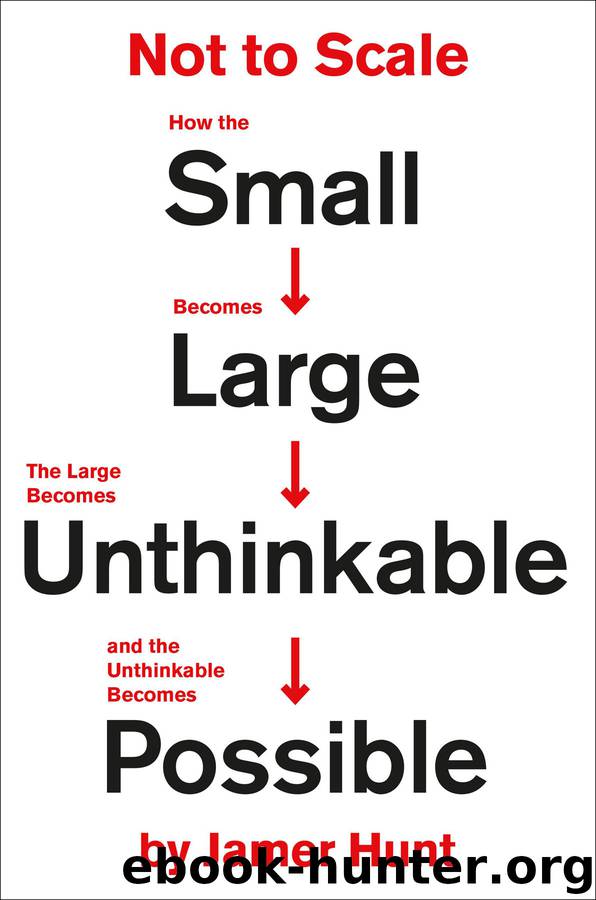Not to Scale: How the Small Becomes Large, the Large Becomes Unthinkable, and the Unthinkable Becomes Possible by Jamer Hunt

Author:Jamer Hunt
Language: eng
Format: epub
Publisher: Grand Central Publishing
Published: 2020-03-03T00:00:00+00:00
Fig. 21. Diagram comparing short and long scales.
A recent BBC News Magazine article asked, “Is Trillion the New Billion?” That there is still a need to clarify what a trillion is—thereby avoiding a simple semantic error that results in a thousandfold miscalculation—in a major British newspaper in 2011 is a testament to the pervasiveness of the misunderstanding. The error is so common that the BBC News Magazine included in a sidebar a short primer attempting to explain to its UK readers what, precisely, a billion and trillion are today.5 While the concept of a trillion is seeping more frequently into our daily vocabulary, it was not always the case. For the generations that lived through most of the twentieth century, a trillion was a rare encounter. The equivalent today is the term quadrillion. Ask yourself: When was the last time that you used the word quadrillion? Possibly never.
Quantities like a billion or a trillion can be challenging to comprehend, despite the fact that most teenagers are able to grasp the mathematical concept (as they are usually obliged to in math class when they learn scientific notation). Just as the metrological development of “physical constants” progressively decoupled measurement from things we could hold or touch, numbers in the billions and the trillions also tend to elude human perception and experience. One can count to a million in about twelve days, to a billion would take about thirty-two years, but to count to a trillion would take over thirty-one thousand years—about as long as human civilization has existed. Which is to say that a person could not do it. These gigantic numbers matter and yet, somehow, they don’t quite matter.6 Their remove from our everyday perceptions means that they live, for most of us, in the realm of fantasy, in the range of “zillions and gazillions.”7 We are at the mercy of metaphors, analogies, and flights of imagination to give true scope and scale to the numbers that are more and more frequently part of our everyday lexicon.
There is an oft-quoted passage that is variously attributed to Joseph Stalin (though it has never been confirmed), “The death of one man is a tragedy; the death of millions is a statistic.” How is it that we can be so moved to respond to the suffering of one individual and yet so callous when confronted with the death of hundreds of thousands or millions? Why does the outrage and compassion not scale linearly? When the numbers ramp up, why does the affective charge decline? There is a numbing quality to numbers of great size.8 We are drawn emotionally to stories and images that convey the suffering of one individual, and yet we seem to shut down when that number gets much larger than two or three. The absence of the possibility of representing the mass loss of human life in some ways alters our ability to process it. We must be reminded to “never forget” holocausts of various populations, as if our emotional faculties reject grappling with these massive losses of human life.
Download
This site does not store any files on its server. We only index and link to content provided by other sites. Please contact the content providers to delete copyright contents if any and email us, we'll remove relevant links or contents immediately.
Hit Refresh by Satya Nadella(9038)
The Compound Effect by Darren Hardy(8808)
Change Your Questions, Change Your Life by Marilee Adams(7635)
Nudge - Improving Decisions about Health, Wealth, and Happiness by Thaler Sunstein(7615)
The Black Swan by Nassim Nicholas Taleb(7010)
Deep Work by Cal Newport(6878)
Daring Greatly by Brene Brown(6444)
Rich Dad Poor Dad by Robert T. Kiyosaki(6401)
Principles: Life and Work by Ray Dalio(6208)
Man-made Catastrophes and Risk Information Concealment by Dmitry Chernov & Didier Sornette(5921)
Playing to Win_ How Strategy Really Works by A.G. Lafley & Roger L. Martin(5916)
Digital Minimalism by Cal Newport;(5663)
Big Magic: Creative Living Beyond Fear by Elizabeth Gilbert(5610)
The Myth of the Strong Leader by Archie Brown(5424)
The Slight Edge by Jeff Olson(5346)
Discipline Equals Freedom by Jocko Willink(5284)
The Motivation Myth by Jeff Haden(5156)
Stone's Rules by Roger Stone(5026)
The Laws of Human Nature by Robert Greene(4996)
